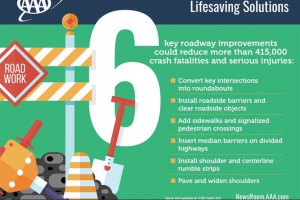
The AAA Foundation for Traffic Safey's six key infrastructure improvements would save more than 63,000 lives.
The Trump Administration has been banging the drum for infrastructure improvements as part of its platform; however, specifics on how he plans to spend billions of dollars improving America’s roads haven’t been released.
The AAA Foundation for Traffic Safety released a report on how money could best be spent. The group suggests that a $146 billion investment in U.S. roadway improvements could potentially save 63,700 lives and prevent 353,560 serious injuries over a 20-year period.
Traffic-related deaths have risen in 2014 and 2015 and are expected to rise again once the final numbers are compiled for 2016. This has occurred in spite of the fact that new vehicles feature more passive and active safety technology than ever.
“We can save tens of thousands of lives and make our roadways safer by investing in improvements that we already know exist,” said Dr. David Yang, AAA Foundation for Traffic Safety executive director. “Now is the time to act by targeting limited resources where they will have the greatest impact.”
(Automakers hoping Trump infrastructure plan will stave off sales slump. Click Here for the story.)
Highway infrastructure improvements can reduce both the likelihood and the consequences of crashes, the report stresses. The report recommends investing $146 billion in six cost-effective improvements that already have a successful track record:
- Converting key intersections into roundabouts
- Installing roadside barriers and clear roadside objects
- Adding sidewalks and signalized pedestrian crossings on the majority of roads
- Installing median barriers on divided highways
- Installing shoulder and centerline rumble strips
- Paving and widening shoulders.
“We must invest in infrastructure improvements that not only account for today’s needs, but also prioritize needs for the future, including the potentially lifesaving technology of autonomous vehicles,” said AAA President and CEO Marshall L. Doney.
Of course, specifics are great, but overall the auto industry would likely also benefit from a substantive infrastructure program.
(Click Here for the details on the rise in drunk driving deaths in the U.S.)
“If you get a $1 trillion stimulus, that could add 800,000 units,” Jim Lentz, CEO of Toyota North America, said during a preview of the maker’s expanded technical center near Ann Arbor, Michigan, on Thursday morning.
While slow sales since January have started to worry many industry observers, manufacturers have not yet made the sort of production cuts that a significant downturn might require. And anticipation for the infrastructure stimulus package, said Lentz, is “one reason everyone is on the accelerator.”
Auto sales dipped 4.7% in the U.S. in April, a sharper decline than had been forecast, and the fourth consecutive down month. Most observers now expect 2017 to bring to an end the long new vehicle boom that followed the worst industry meltdown since the Great Recession.
But how far down things will go is uncertain. IHS Automotive, for one, is predicting the numbers will dip to 17.4 million for all of 2017, off just about 100,000 units from last year – 2016 marking the third consecutive annual industry record.
(Death toll rises as U.S. drivers keep engaging in distracted driving. Click Here for the story.)
That said, analyst Stephanie Brinley said more declines like April could lead the consulting firm to rejigger its numbers, and others, such as LMC Automotive, have already reduced their 2017 forecasts.
